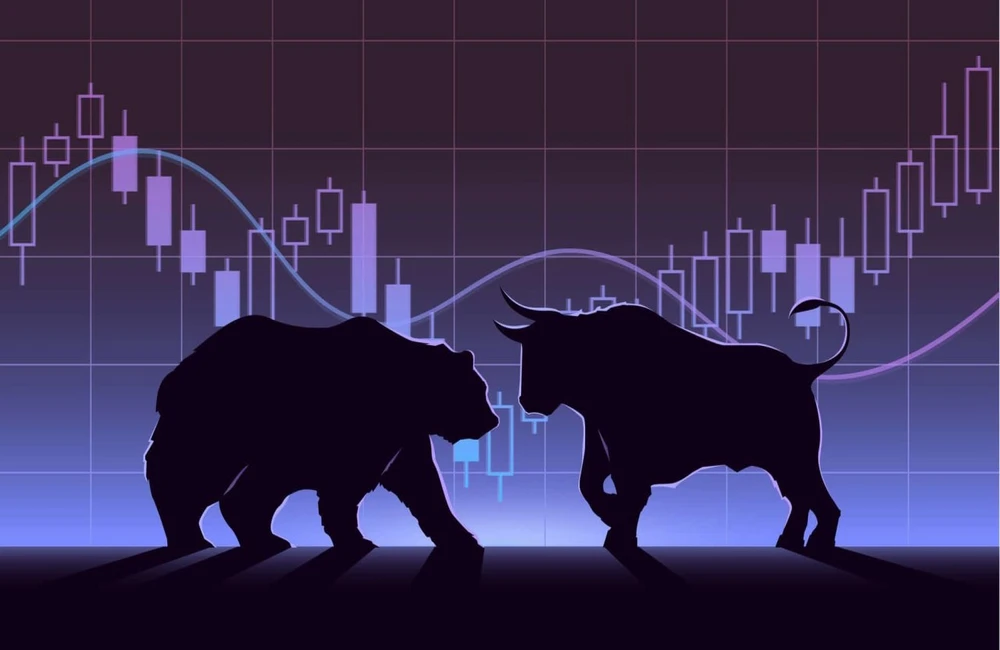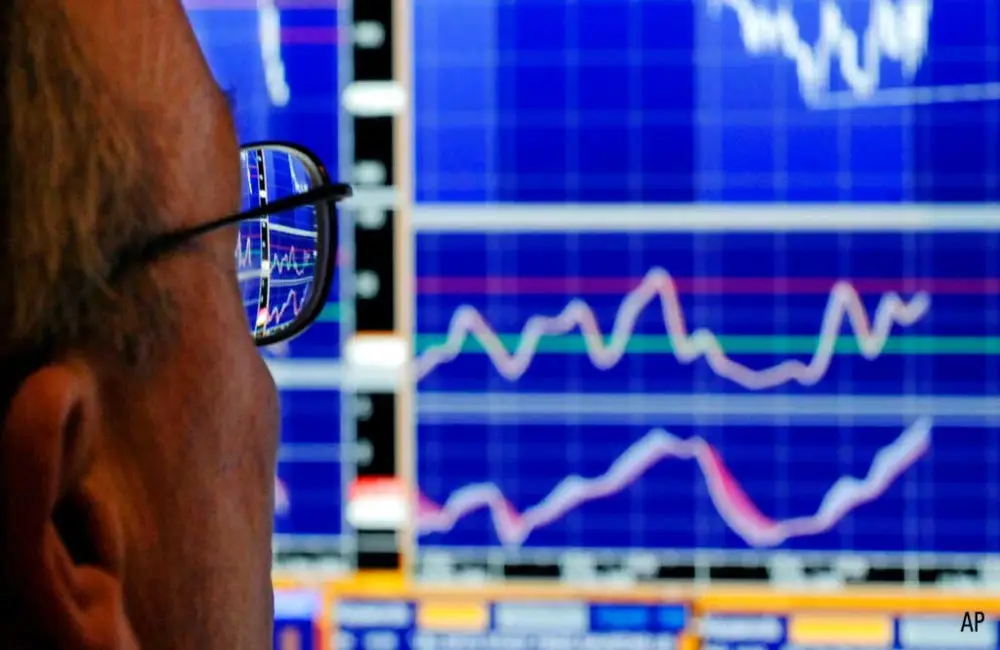Wall Street declined on Friday, ending a tumultuous week in which stocks, bonds and oil prices swung between gains and losses as investors reacted to the war in Ukraine.
ASX futures were 20 points or 0.3% higher at 7071 at 8:00am AEST which indicates a positive start to the trading day likely to be very tough for Friday’s negative close in the US. Opening gains crumbled into losses Monday and Tuesday in a volatile week of trading.
The blue-chip Dow Jones Industrial Average closed Friday down 0.7%. The S&P 500 slid 1.3 percent, and the tech-heavy Nasdaq Composite lost 2.2 percent. The information technology sector of the S&P 500 was among several that dropped more than 1 percent on Friday; all 11 are in the red for the day.
Stocks had a jagged week as global markets weighed the effects of Russia’s invasion of Ukraine on growth, inflation and interest rates. On Monday, surging oil prices sent stocks plunging, and the S&P 500 had its biggest drop in more than a year. It surged 2.6 percent two days later, its largest increase since 2020.
This week may find even more choppiness. On Tuesday and Wednesday (US time), the US Federal Reserve will meet to decide whether to increase the base interest rate and by how much. A ruling is expected on Thursday (AEST).
In a sign of increasing tensions, Russia’s deputy foreign minister said on Saturday that Western arms convoys to Ukraine were “legitimate military targets.” The next day, Russian missile attacks on a Ukrainian military base near the Polish border left 35 dead. 訓練有 Western instructors with.
The S&P/ASX 200 finished 0.9% lower at 7063.6 on Friday, which wiped out a weekly gain, after the rally of the past two sessions lost steam.
The tech, consumer and health sectors, which led losses, followed a negative lead from US stocks, while the heavyweight financial sector retreated 0.6% after a run-up since Wednesday. Block, WiseTech and Xero dropped between 3.2% and 5.9%, and buy-now-pay-later company Zip Co. slumped 7.6% to the lowest in two years.
Losses in the financial sector were led by wealth managers and insurers. Commonwealth and NAB lost 0.4% and 0.2%, respectively. Shares of commodity stocks added a little. The ASX 200 lost 0.7% for the week.
In commodity markets, gold futures lost 0.8% to $1985.00; Iron ore lost 1.2% to US$154.50 per tonne; Brent Crude gained 3.3% to US$112.67 a barrel.
In the bond markets, US 10-Year Treasury Notes yields were unchanged at 1.99%. At home, the yield on Australia’s 10-year bond rose to 2.39%. Yields rise when prices fall.
The Australian dollar gave ground in a sloppy trade, buying 72.90 US cents at 8:00am AEST, compared with the previous close of 73.56. The WSJ Dollar Index, which measures the US dollar against 16 other currencies, surged to 91.67.
Asia
Chinese stocks finished the session higher, while Friday continued a recovery from steep losses earlier in the week. The rise was led by the medical industry, as growing infections of Covid-19 in the country are creating hopes for strong demand for health equipment and services. The benchmark Shanghai Composite Index was up 0.4 percent, the Shenzhen Composite Index gained 0.6 percent, and the ChiNext Price Index, a gauge of emerging industries and start-ups, added the most, 1.1 percent. The gains were led by medical companies, including medical device makers, pharmacy operators and biotech firms. Industrial companies such as chemicals suppliers also bolstered as crude prices relaxed, easing cost worries.
Hong Kong shares closed lower, with investors dumping tech stocks after the US Securities and Exchange Commission suggested a list of five companies that may be delisted if they fail to meet US accounting requirements. That sparked market fears that other US-traded Chinese firms, most of them tech companies, would follow on the list, Citi said. The benchmark Hang Seng Index dropped 1.6% and the Hang Seng TECH Index plunged 4.3%. JD. com tumbled 11%, leading losses, and Meituan and Alibaba lost 6.1% and 5.5%, respectively.
Japanese stocks closed lower, weighed down by declines in tech and electronics stocks amid ongoing uncertainty around the war in Ukraine and its effect on world trade. Lasertec lost 9.0% and SoftBank Group fell 6.2%. The Nikkei Stock Average dropped 2.1%. Investors still have their eyes on Ukraine.
Europe
European stocks closed higher, with market sentiment boosted as Russian President Vladimir Putin said some progress had been made in talks with Ukraine. The pan-European Stoxx Europe 600 rose 1 percent.
Putin hints that negotiations may even be showing some signs of progress has been enough to induce a rally throughout the markets, even though some optimism has been pared,” IG analysts say.
“There is still no sign of any real deal emerging, and Russia’s previous substantive aims still appear to be in element, implying this rally could go the way of so many others recently, where markets still don’t have the underpinning for a meaningful bounce.”
In London, the FTSE 100 hovered 0.8% higher after plunging to multi-month lows on Monday and rallying hard on Wednesday, according to CMC Markets UK.
“We have also seen some gains in the space of travel and leisure stocks although, once more, we are off the highs, with eastern European-focused Wizz Air leading the charge, followed by easyJet and IAG,” it said. The bounces we’ve seen this week look a decent way off in the distance, according to CMC Markets UK, but zoom in the time frame and those shares are still a lot lower than they were before the Russia-Ukraine row. That daily moves are outsized comes as investors try to make sense of developments at a time when the outlook is still extremely uncertain.
Russia’s stock market was closed Friday. The ruble strengthened against the greenback in offshore trading, at around 114 rubles per dollar. Pricing the ruble has become difficult since Russia took steps to limit the selloff of its currency and after Western banks have avoided Russian assets.
North America
Technology stocks continued to slide on Friday, pulling indexes lower for the week, as volatility reigned and inflation pressures resurfaced.
The stocks opened higher, as traders bought stocks following remarks from Russian President Vladimir Putin that there had been positive developments during talks with Ukraine, despite Russian forces continuing to bombard Ukrainian cities. By the afternoon, the S&P 500, Dow Jones Industrial Average, and Nasdaq Composite all reversed, as investors gauged the risk of entering the weekend with stocks.
All three indexes ended the week in the red despite Friday’s selloff. The Dow industrials ended down roughly 2% over the period, marking its fifth-straight weekly decline. The S&P 500 and Nasdaq Composite fell 2.9 percent and 3.5 percent this week, respectively, marking the fourth weekly decline in the last five weeks for both indexes. The Nasdaq Composite remains the worst performer of the three major indexes this year, down 18% through Friday’s close.
Volatile swings have become the norm for major stock indexes these days, but even by those standards, this week’s moves up and down were extreme, some investors and traders said. On Monday, spiking oil prices sent stocks crashing, with the S&P 500 slumping through its worst day in over a year. Two days later, the benchmark index soared 2.6 percent, its largest advance since 2020.
The week ahead could offer more choppiness. Next Tuesday and Wednesday, members of the Federal Reserve gather to cast their votes about whether to increase the base interest rate — and by how much. Rate cuts are not on the table this meeting, with 96% odds seen through Fed-funds futures, the tools traders use to bet on interest-rate moves of a 0.25-percentage-point interest-rate hike at the meeting. A month ago, they indicated about a 50% chance of a 0.50 percentage point rate hike.
Justin Wiggs, a managing director in equity trading at Stifel Nicolaus, said orders were coming in at a dizzying pace at the beginning of the week. By the end of the week, he said, things had slowed, and many clients seemed resigned to the maddening lack of clarity in the market.
“It’s almost like we’re in purgatory. You’re trying to invest, and there’s a ton of stuff you can’t model,” he said, mentioning swings in energy prices, how the war will play out, and the trajectory of rate increases and inflation. “It’s morphed, pretty much, into a sentiment game.”
The more closely watched Dow Jones Industrial Average fell 0.7% on Friday. The S&P 500 declined 1.3 percent and the tech-focused Nasdaq Composite fell 2.2 percent. The S&P 500’s information technology sector was among several that fell more than 1 percent on Friday; all 11 sectors were in the red for the day.
“Everyone’s on edge,” said Joseph Amato, chief investment officer of equities at Neuberger Berman Group LLC. The market can be poised for a comeback, if the Ukraine crisis deescalates, he said, but markets can also be more surf and turf and may fall again if it worsens.
Investors and traders said they were also preparing for more Western sanctions imposed against Russia. President Biden said on Friday that the United States would follow its major allies and the European Union in moving to revoke normal trade relations with Russia.
Mr. Amato said one of his major worries is that the crisis in Europe could slow global economic growth and maintain inflation at multi-decade highs. The consumer-price index data released Thursday in the US indicated energy prices accounted for the bulk of inflation last month. The data didn’t cover March, when oil prices soared.
Among the worst performers this week: technology companies. The Nasdaq Composite on Monday qualified as being in bear market territory defined as being 20% below its recent high. Soaring inflation has squeezed tech stocks, traders said, as it can result in higher interest rates and bond yields that tarnish growth stocks’ promised future cash flows. The tech sector of the S&P 500 ended the week down 3.8%.
Shares of DocuSign sank $18.87, or 20 percent, to $75.01 after the software maker gave guidance that was weaker than expected. Oracle shares gained $1.17, or 1.5 percent, to $77.82 after it said that its cloud-business revenue soared 24 percent from a year earlier.
Energy companies were standouts this week, gaining as the price of oil rose. While energy stocks in the S&P 500 declined Friday, they were the only sector to finish the week in the positive, up 1.9%. Brent crude futures, the global oil standard, rose 3.1 percent to $112.67. They were trading above $127 earlier this week. Oil prices are around their highest level in years, even though they dipped back in recent days. Earlier this week, the United Arab Emirates announced it would urge the Organization of the Petroleum Exporting Countries to increase oil production, easing some concerns about a supply squeeze.
Market turbulence has left investors scrambling to rebalance portfolios. Investors have flowed into and out of safer assets in recent weeks as news reports about the conflict have quickly shifted.
























